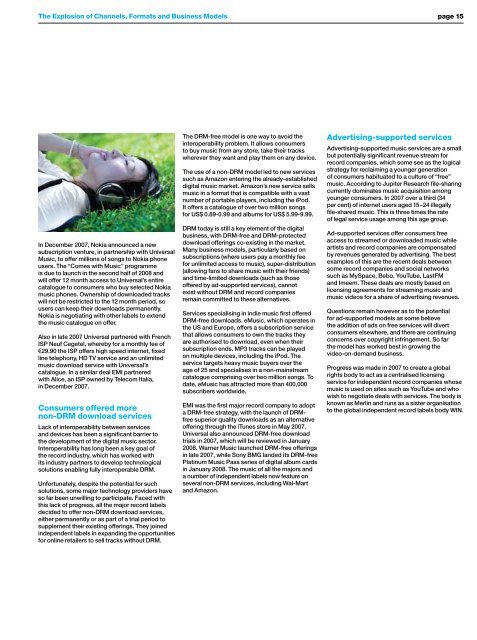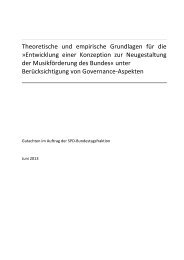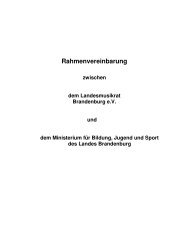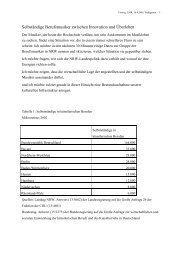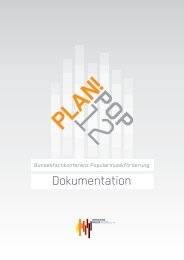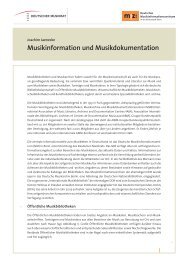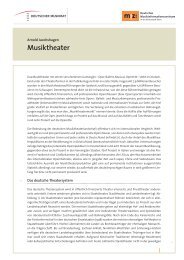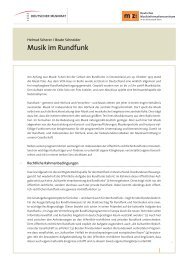You also want an ePaper? Increase the reach of your titles
YUMPU automatically turns print PDFs into web optimized ePapers that Google loves.
The Explosion of Channels, Formats and Business Models page 15<br />
In December 2007, Nokia announced a new<br />
subscription venture, in partnership with Universal<br />
<strong>Music</strong>, to offer millions of songs to Nokia phone<br />
users. The “Comes with <strong>Music</strong>” programme<br />
is due to launch in the second half of <strong>2008</strong> and<br />
will offer 12 month access to Universal’s entire<br />
catalogue to consumers who buy selected Nokia<br />
music phones. Ownership of downloaded tracks<br />
will not be restricted to the 12 month period, so<br />
users can keep their downloads permanently.<br />
Nokia is negotiating with other labels to extend<br />
the music catalogue on offer.<br />
Also in late 2007 Universal partnered with French<br />
ISP Neuf Cegetel, whereby for a monthly fee of<br />
€29.90 the ISP offers high speed internet, fixed<br />
line telephony, HD TV service and an unlimited<br />
music download service with Universal’s<br />
catalogue. In a similar deal EMI partnered<br />
with Alice, an ISP owned by Telecom Italia,<br />
in December 2007.<br />
Consumers offered more<br />
non-DRM download services<br />
Lack of interoperability between services<br />
and devices has been a significant barrier to<br />
the development of the digital music sector.<br />
Interoperability has long been a key goal of<br />
the record industry, which has worked with<br />
its industry partners to develop technological<br />
solutions enabling fully interoperable DRM.<br />
Unfortunately, despite the potential for such<br />
solutions, some major technology providers have<br />
so far been unwilling to participate. Faced with<br />
this lack of progress, all the major record labels<br />
decided to offer non-DRM download services,<br />
either permanently or as part of a trial period to<br />
supplement their existing offerings. They joined<br />
independent labels in expanding the opportunities<br />
for online retailers to sell tracks without DRM.<br />
The DRM-free model is one way to avoid the<br />
interoperability problem. It allows consumers<br />
to buy music from any store, take their tracks<br />
wherever they want and play them on any device.<br />
The use of a non-DRM model led to new services<br />
such as Amazon entering the already-established<br />
digital music market. Amazon’s new service sells<br />
music in a format that is compatible with a vast<br />
number of portable players, including the iPod.<br />
It offers a catalogue of over two million songs<br />
for US$ 0.89-0.99 and albums for US$ 5.99-9.99.<br />
DRM today is still a key element of the digital<br />
business, with DRM-free and DRM-protected<br />
download offerings co-existing in the market.<br />
Many business models, particularly based on<br />
subscriptions (where users pay a monthly fee<br />
for unlimited access to music), super-distribution<br />
(allowing fans to share music with their friends)<br />
and time-limited downloads (such as those<br />
offered by ad-supported services), cannot<br />
exist without DRM and record companies<br />
remain committed to these alternatives.<br />
Services specialising in indie music first offered<br />
DRM-free downloads. e<strong>Music</strong>, which operates in<br />
the US and Europe, offers a subscription service<br />
that allows consumers to own the tracks they<br />
are authorised to download, even when their<br />
subscription ends. MP3 tracks can be played<br />
on multiple devices, including the iPod. The<br />
service targets heavy music buyers over the<br />
age of 25 and specialises in a non-mainstream<br />
catalogue comprising over two million songs. To<br />
date, e<strong>Music</strong> has attracted more than 400,000<br />
subscribers worldwide.<br />
EMI was the first major record company to adopt<br />
a DRM-free strategy, with the launch of DRMfree<br />
superior quality downloads as an alternative<br />
offering through the iTunes store in May 2007.<br />
Universal also announced DRM-free download<br />
trials in 2007, which will be reviewed in January<br />
<strong>2008</strong>. Warner <strong>Music</strong> launched DRM-free offerings<br />
in late 2007, while Sony BMG landed its DRM-free<br />
Platinum <strong>Music</strong> Pass series of digital album cards<br />
in January <strong>2008</strong>. The music of all the majors and<br />
a number of independent labels now feature on<br />
several non-DRM services, including Wal-Mart<br />
and Amazon.<br />
Advertising-supported services<br />
Advertising-supported music services are a small<br />
but potentially significant revenue stream for<br />
record companies, which some see as the logical<br />
strategy for reclaiming a younger generation<br />
of consumers habituated to a culture of “free”<br />
music. According to Jupiter Research file-sharing<br />
currently dominates music acquisition among<br />
younger consumers. In 2007 over a third (34<br />
per cent) of internet users aged 15–24 illegally<br />
file-shared music. This is three times the rate<br />
of legal service usage among this age group.<br />
Ad-supported services offer consumers free<br />
access to streamed or downloaded music while<br />
artists and record companies are compensated<br />
by revenues generated by advertising. The best<br />
examples of this are the recent deals between<br />
some record companies and social networks<br />
such as MySpace, Bebo, YouTube, LastFM<br />
and Imeem. These deals are mostly based on<br />
licensing agreements for streaming music and<br />
music videos for a share of advertising revenues.<br />
Questions remain however as to the potential<br />
for ad-supported models as some believe<br />
the addition of ads on free services will divert<br />
consumers elsewhere, and there are continuing<br />
concerns over copyright infringement. So far<br />
the model has worked best in growing the<br />
video-on-demand business.<br />
Progress was made in 2007 to create a global<br />
rights body to act as a centralised licensing<br />
service for independent record companies whose<br />
music is used on sites such as YouTube and who<br />
wish to negotiate deals with services. The body is<br />
known as Merlin and runs as a sister organisation<br />
to the global independent record labels body WIN.


